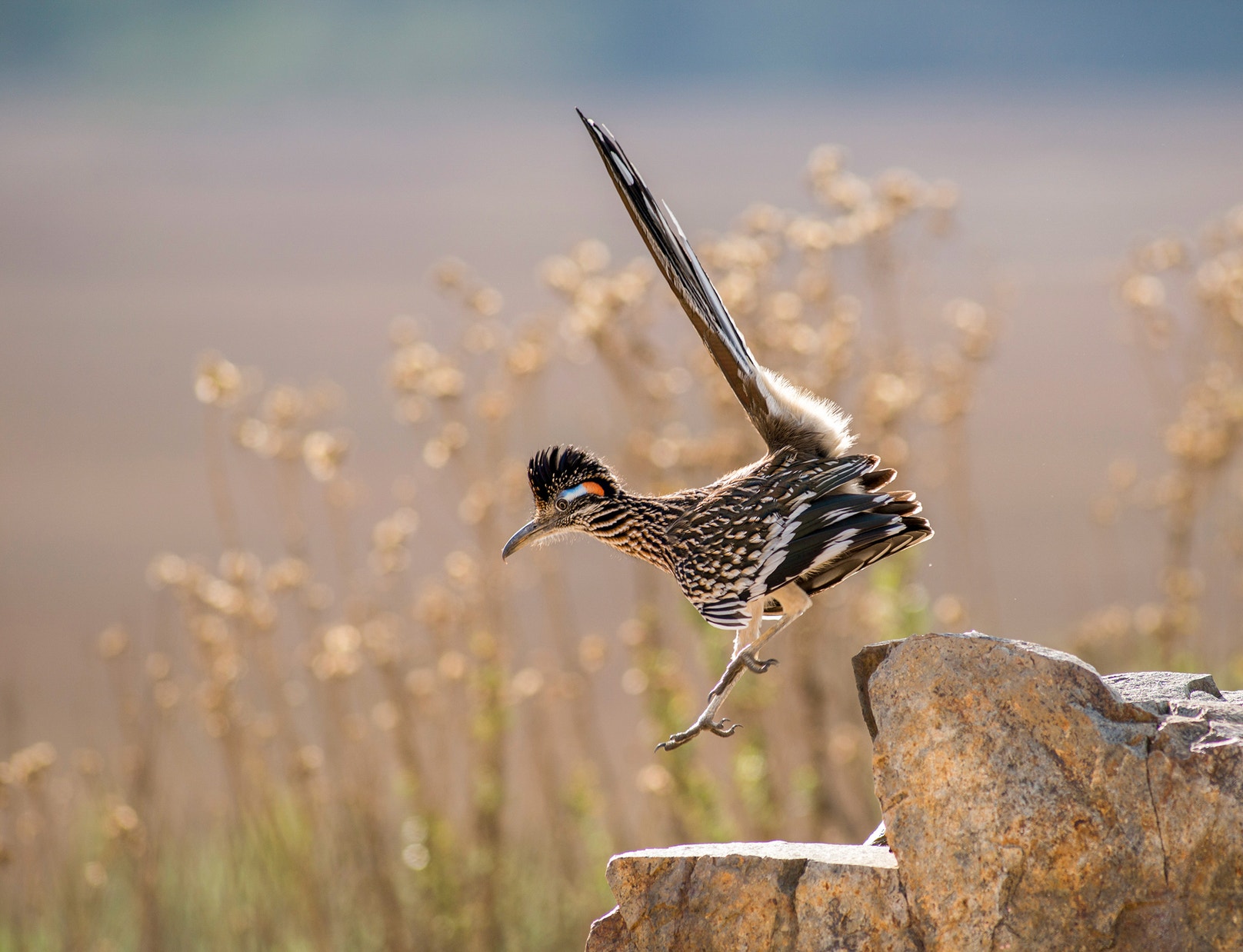A Bird You Need to See: the Greater Roadrunner
Spotting this speedy desert dweller in the wild is about as surreal as birding gets.
Greater Road  runner. Photo: Sandrine Biziaux-Scherson/Audubon Photography Awards runner. Photo: Sandrine Biziaux-Scherson/Audubon Photography Awards
By Andrew Del-Colle
Digital Editorial Director, Audubon magazine
Published July 01, 2025
I heard the sound first: a strange clattering. I hadn’t even been in Arizona for 24 hours, but I'd already learned enough of the soundscape behind our Phoenix Airbnb—the Verdins, the Cactus Wrens, the Abert’s Towhees—to know this was something different, something new. Was it even a bird? Our rental backed up to a golf course, so from the fence I began scanning the brushy desert habitat that surrounded the lush green tee boxes nearby.
And then I suddenly saw it: A Greater Roadrunner zoomed into view and hoppedatop one of the tee boxes to survey its surroundings. I focused my binoculars to get a better look at the bird, a lifer for me, and that’s when I realized that its bill was the source of the clacking. As it stood tall and inquisitively cocked its head from side to side, the bird quickly and loudly clapped its slender beak together.
I stood there astonished. First off, because I didn't know Greater Roadrunners rattled their bills to communicate or warn off predators. But also because, despite being a birder my whole life, I clearly was not prepared to see this staple of the American southwest. It was bigger than I expected—a lot bigger. I imagined something more the size of a Northern Flicker or even a Pileated Woodpecker, not the size of a Chachalaca. And the red and blue skin patches on this male's face were incredibly bright. From its jaunty long tail to its mussy crest, this member of the cuckoo family was like no species I'd seen before.
Roadrunners move and look like modern dinosaurs, as if they are tapping into some long-lost velociraptor DNA.
I tracked the bird as it raced off the tee box and through thechaparral and other shrubbery seeking its next meal—maybe a lizard, a snake, or even a scorpion. And that’s when it struck me: Roadrunners look and move like modern dinosaurs, as if they are tapping into some long-lost remnant of velociraptor DNA. Once I’d made that connection, the idea was impossible to shake as I watched the seemingly primeval avian disappear out of sight.
Although the bird was a first for me, my excitement far exceeded that of seeing a new bird. Almost all of the birds I'd seen since getting to Phoenix had been lifers, after all, and many of them were already new favorites—namely those cheery Verdins, with their sunburst faces, and the Black-tailed Gnatcatchers, which are perfect birds as far as I'm concerned.

Greater Roadrunner
Size: 24" (61 cm); About the size of a Crow; About the size of a Mallard or Herring Gull
Range: Permanent resident, but some (young birds?) may wander considerable distances.
Status: Least Concern
The most famous bird in the southwest, featured in folklore and cartoons, known by its long tail and expressive crest. The Roadrunner walks and runs on the ground, flying only when necessary. It can run 15 miles per hour, probably with much faster spurts when chasing a fast-running lizard or other prey. Its prowess as a rattlesnake fighter has been much exaggerated, but it does eat a remarkable variety of smaller creatures.
View Bird GuideAdult. Photo: Sandrine Biziaux-Scherson/Audubon Photography Awards
But there’s something special about seeing a roadrunner, and it’s hard to put your finger on it. Maybe it’s the fact that so many of us grew up knowing this bird from popular culture and cartoons, as inaccurate as the Looney Tunes version’spurple plumage and car-horn calls might be. Or maybe it’s just the sheer idea of them—that these speedy desert dwellers capable of hitting 15 mph and with undeniable dinosaur vibes exist in the first place. Whatever it is, the singular sense of awe they evoke is undeniable.
It’s been eight years since that encounter, and I haven’t seen a roadrunner since. If I’m lucky, I’ll see many more in my lifetime, but that morning will always stand out as one of my most memorable birding moments. Some of those memories are defined by the chase or the search. Others by who I was with. But this one was neither—it was all about the sheer awesomeness of the bird itself. And for that reason, the Greater Roadrunner isn’t just a bird everyone needs to see at least once, but it’s a bird I know I have to see again. |





 runner. Photo: Sandrine Biziaux-Scherson/Audubon Photography Awards
runner. Photo: Sandrine Biziaux-Scherson/Audubon Photography Awards